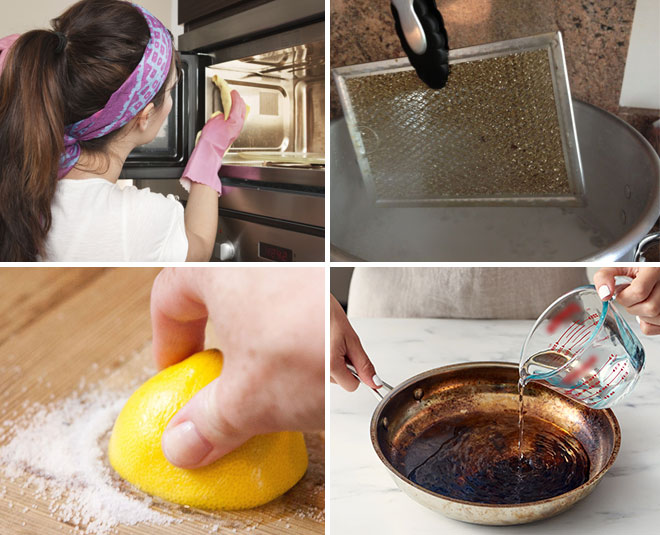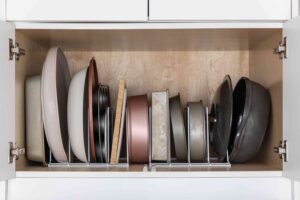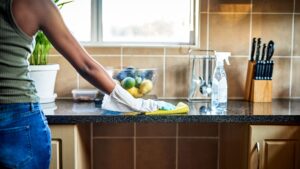Keeping your kitchen clean can seem like an endless battle, but with the right tips you can make it easier and faster. Here are seven kitchen cleaning tips that work, from removing odors to removing tough stains.
1. Scrub Your Cutting Board with Lemon and Salt:
Over time, cutting boards can become dirty and smelly from different foods. Use a simple lemon and salt scrub to clean and freshen your cutting boards. On a cutting board, cut the lemon halves and sprinkle with kosher salt. Then scrub the surface with the sliced lemon and squeeze lightly to squeeze out the juice. The acid in the lemon breaks down stains and kills bacteria, and the rough texture of the salt helps remove dirt and grime. Then rinse the cutting board with water to make it clean, fresh, and ready to use.
2. Clean the Oven with Vinegar and Baking Soda
Cleaning the oven is something that many people dread, but a trick with vinegar and baking soda makes it so much easier. First, remove the oven rack and soak it in warm, soapy water. Then pour equal parts white vinegar and water into a spray bottle. Spray the inside of the oven liberally. Then sprinkle the baking soda on the damp surface, making sure to focus on any grease or stains that won’t come off. Let the mixture sizzle and work its magic for at least 15 to 20 minutes. Then wipe away the dirt with a damp sponge or cloth. Finally, rinse the surface with clean water and return the oven rack to its original position. You don’t need to use harsh chemicals to clean your oven.
3. Steam Clean Microwave with Lemon
Many foods quickly stick to microwave ovens, making them look dirty and unsightly. To clean your microwave easily, you can use steam and lemon. Place a few lemon slices in a microwave-safe bowl. Fill the bowl with water. Place the bowl in the microwave and heat on high for three to five minutes, or until the water begins to boil and steam begins to fill the bowl. Leave the microwave door closed for a few more minutes to allow the steam to break down any dried food. Then carefully remove the bowl (it is hot!) and clean the inside with a damp cloth. The steam softens the dirt so it can be easily rinsed away and the lemon leaves a refreshing, clean scent.
4. Polish Stainless Steel Products with Olive Oil
Steel appliances in your kitchen can make it look sleek and modern, but they are also prone to fingerprints and smudges. Instead of spending a lot of money on stainless steel cleaners, try using olive oil to restore shine and remove fingerprints. To clean stainless steel, simply apply a little olive oil to a soft cloth and rub it in the direction of the grain. This oil helps remove fingerprints and restore the natural shine of the metal. The bottom line is that olive oil is safe to use in food preparation areas. Then wipe the surface with a clean, dry cloth to remove excess oil and leave a streak-free shine.
5. Baking Soda Paste Removes Stains from the Stove
Grease splatters and stubborn stains can quickly cover your hob, especially if you cook often. To clean up those stubborn messes, mix baking soda and water into a paste. Add enough water to the baking soda to make a thick paste that can be spread. The paste should be applied to the dirty parts of the stove and left there for 10 to 15 minutes to remove the dirt. Then use a brush or sponge to gently scrub the surface, making sure to focus on the areas that won’t come off. Because baking soda is abrasive, you can remove stains from your stovetop without scratching it. After scrubbing, wipe off the paste with a damp cloth. Then take a look at your clean, shiny stove.
6. Coffee Grounds to Remove Odors
If your kitchen still smells bad from cooking or food waste, coffee grounds can help remove the odor. Simply place the used coffee grounds in a small bowl or bag and place it on the counter or near the source of the odor. Coffee grounds absorb and remove odors, leaving your kitchen smelling clean and fresh. Putting a bowl of coffee grounds on a shelf is another way to clean your refrigerator. Remember to replace the coffee grounds once a week to keep them working properly.
7. Vinegar and Dish Soap All-Purpose Cleaner
Mix white vinegar and dish soap to create an inexpensive but effective all-purpose cleaner that can tackle a variety of kitchen messes. Add equal parts vinegar and dish soap to a spray bottle. Then fill the bottle with water until it is full. After shaking well to combine the ingredients, you have a powerful cleaner that removes grease, food residue, and bacteria from surfaces. Use it to clean tables, sinks, appliances and more. Dishwashing liquid provides extra cleaning power and a pleasant scent, while vinegar breaks down grease and dirt. Moreover, the cleaning product you make at home is safe for children, pets, and the environment.
Conclusion
All in all, keeping your kitchen clean and germ-free doesn’t have to be difficult. You can easily remove stains, grease, and odors with these seven handy cleaning tips, using things you probably already have in your pantry. With these tips, you will ensure that your kitchen remains spotless. For example, lemon and vinegar cleanse naturally, and baking soda and olive oil can be used in different ways. By using these cleaning tips, you can keep your kitchen clean and tidy while reducing the time and effort required to maintain it. Roll up your sleeves, try these tips, and enjoy a wonderfully clean kitchen.
FAQs
1. Are these simple ways to safely clean your kitchen?
Most cleaning tips use natural ingredients that are safe to use in the kitchen, such as lemon, vinegar, baking soda, and olive oil. But it’s always a good idea to test a small area first, especially on easily damaged surfaces, to make sure it works properly.
2. How often should I clean with these tips?
How often you use these tips depends on how often you use your kitchen and how clean it is. Some tips, such as using vinegar and dish soap to clean your countertops, can be done every day. Other methods, such as using vinegar and baking soda to deep clean your oven, may only need to be done every few months.
3. Can I use these cleaning tips for something else?
Although these hacks are made with certain ingredients that are known to cleanse well, you can try other ingredients if you wish. In some tips, you can use vinegar instead of lemon, and for shiny stainless steel, you can use an oil other than olive oil.
4. Can I use these tips to clean different kitchen surfaces?
In most cases, these tips are safe to use on kitchen surfaces such as stoves, countertops, cutting boards, and stainless steel appliances. But it’s important to consider the surface material and do a field test if you’re not sure they will work together. For example, harsh cleaning methods may not work on marble or granite, both very delicate surfaces.
5. Should I wash my hands with water after using these cleansers?
It’s usually best to rinse a cleaning product after using it, especially if it contains products that contain acidic ingredients such as lemon or vinegar. For some tips, you can wipe the surface with a dry cloth instead of rinsing, such as using olive oil to polish stainless steel appliances.
6. Are these cleaning tips safe for the environment?
Yes, many of these hacks use natural ingredients that are safe for the environment and break down naturally. This makes them a better choice than store-bought cleaners that may contain harsh chemicals. Additionally, making your cleaning products can reduce the use of single-use plastic containers.


